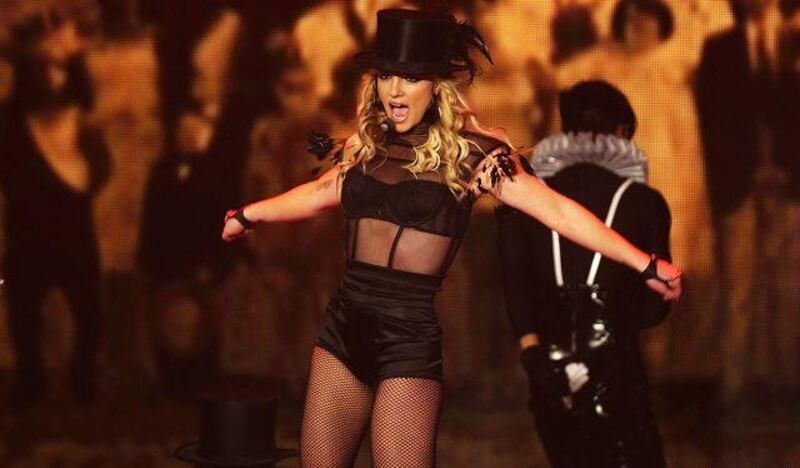"Britney Spears in Australian lip-synching row"; "Australian mime reports 'fabrication', says promoter"; "Britney in lip-synching controversy." Last week, Britney Spears made headlines across the world after a Sydney newspaper ran a front-page story complaining that she would not be singing live during her current Australian tour. Virginia Judge, the New South Wales minister for fair trading, said Australians would not tolerate a "Mickey Mouse" performance by Spears and suggested that concert tickets should carry disclaimers about whether parts of concerts are pre-recorded and mimed.
The Britney camp was furious, but not because of the mime accusation. "It's been all over the internet for nine months," said her Australian promoter. "This show is about an incredible spectacle, which it is." What really angered him was the claim that disgruntled fans stormed out of a performance in Perth. It's unlikely they did. The reason? Everyone knows that Spears mimes. In fact, it's accepted practice in the music industry that live shows by pop performers may be all-dancing, but rarely are they all-singing, too.
The award-winning producer Steve Osbourne (The Happy Mondays' Pills ' n' Thrills and Bellyaches) sums the up situation: "If you are dancing you are miming," he says. "If you weren't, we'd hear you panting between verses." But while a pop audience in love with the "spectacle" might not care if their stars take a singing break during dance routines, for other performers, being outed for lip-synching can be career suicide. Yet despite the risk of a PR flogging, more and more artists are getting caught out.
The former Whitesnake vocalist David Coverdale was recently accused by the ex Rainbow singer Joe Lynn Turner of miming. For a grizzled road hog such as Coverdale, this was beyond the pale. "I do not, have not and will not use tapes of my voice to mime in concert," said Coverdale. Roger Waters has been repeatedly accused of miming to a pre-recorded track of one of his old vocals. Waters refused to comment for this piece, but in an interview in 1999, an ex-Pink Floyd bandmate, the late Rick Wright, said that after attending a Waters gig: "I subsequently heard that his vocals were taped."
Ashlee Simpson was roundly mocked when she was caught miming last year after a playback failed during the US TV show Saturday Night Live. Her career has never recovered. Journey's Steve Augeri was caught miming during a recent tour. He blamed ill health. At the 2004 Q awards, Elton John accused Madonna of miming, saying: "Anyone who lip-synchs in public on stage when you pay £75 to see them should be shot." Madonna immediately hit back, accusing John of "trashing fellow artists".
Jennifer Hudson, in her first appearance since the October 2008 murder of her mother, brother and nephew, lip-synched her performance of the US national anthem at this year's Super Bowl. And at President Obama's inauguration everyone, including U2 and the cellist Yo-Yo Ma, mimed. Everyone, that is, except one of the greatest voices in music, Aretha Franklin, who wished she had. "Everyone else pre-recorded. I should have! I didn't even know they had pre-recorded until I heard it on TV later," she said.
Why do so many artists mime? The simple answer is: because they can. Lip-synching is a possibility due to the popularity of in-ear monitoring, says Lily Allen's sound engineer, John Delf. This aural plug-in allows the band and singer to hear themselves perform, and also hear a click track that can help them stay in metronomic time. With the band playing to a digitally regimented beat, all kinds of pre-recorded jiggery-pokery can be added to the live mix by sound engineers.
"Britney Spears would probably use a backing track mixed underneath that will have a good vocal," says Delf. "This can be boosted when she is doing some dancing. A lot of artists use double tracking, too. You add delay to their voice and mix it back in. It's a small enough gap not to sound like an echo and thickens their voice," he says. According to the Noisettes front of house engineer Briony October, almost all singers use some technical assistance to help them wow their audiences. "Reverb is seen as magic dust," she says. "Some artists even call it 'the talent'. They say: 'Turn up the talent'."
For Caroline Adcock, who twiddles knobs for Au Revoir Simone, many artists' voices deteriorate over the years and may need extra help. "By the time they get into their 60s they could sound completely different," she says. Recent performances by Dolly Parton, 63, left some concertgoers wondering whether she had some assistance from the mixing board. But it is TV that has really forced the hand of some of the industry's weaker singers. Shows such as The X Factor, Pop Idol and American Idol have raised the bar of what audiences expect from a singer in a live setting, says Adcock.
She says that in the Eighties, singing ability was a secondary concern for many pop groups. "That's not the case now. Audiences have been conditioned to expect perfection." And this leads to more miming instead of less, as audience expectations cause artists to abandon their artistry in the name of flawlessness. The result can be lifeless. "To banish imperfection," wrote the 19th-century critic John Ruskin, "is to destroy expression, to check exertion, to paralyse vitality."
"The bands I like are real," says Delf, "for better or worse. And for me, it's mostly for the better."





